Have you ever looked upon a grand brick house with impeccable symmetry, soaring windows, and a dominating presence? You were most likely staring at a beauty of Georgian home design. This architectural and interior style movement was alive and well during a revolutionary period in American and British history and embodies an era of elegance, order, and classicism. But in today’s high-tech, modern society, does the stuffiness of Georgian home design have any hold, or is it simply a beautiful relic of a bygone era? Let us unlock the timelessness and unforeseen adaptability of this noble style.
The very essence of Georgian home design rests upon the principles of classical antiquity – proportion, equanimity, and dignity. It speaks to a requirement for steadiness and elegance that perhaps we still strive for today. Though perhaps seen as grand and even monumental, the underlying elegance and sense of logic inherent in Georgian design is a guide for designing spaces that are as impressive as they are deeply cozy. But how can you bring the refinement of Georgian style into your modern home without it seeming too formal or irrelevant? We’ll explore the building blocks and see how this classic can be updated for the modern age.
Table of Contents
Dismantling the Pillars of Georgian Home Style
The distinct character of Georgian home style is a product of a clearly outlined body of architectural and design principles that became universally accepted under the four Georges’ rule in Britain (1714-1830).
Symmetry and Proportion: The Hallmarks of Georgian Beauty
If there is one word that describes Georgian homestyle, it’s symmetry. This’s not just about things being aesthetically pleasing; it’s an actual reference to ancient Roman and Greek architecture, with ideals of order, rationality, and balance.
- Exterior Harmony: Georgian residences are easily recognizable by their symmetrical fronts. Windows are normally evenly spaced, there are pairs of chimneys, and the front entrance is in the center, sometimes being preceded by paired pilasters or columns.
- Interior Symmetry: Such emphasis on symmetry extends within. Rooms are rectangular, fireplaces are centered, and architectural features like built-in bookshelves or alcoves usually appear symmetrically repeated on facing walls. Do you feel safe in such orderly predictability, or do you prefer a more natural arrangement?
- Mathematical Proportions: Georgian architects used mathematical proportions taken from classical antiquity with great care in designing window dimensions, the proportions of rooms, and building proportions as a whole. By adhering to an universal aesthetic code, this served to give them an inherent feeling of solidity and grandeur (Source: The Georgian Group, a UK charity that cares about Georgian architecture).
Classical Influences: A Tip of the Hat to Antiquity
The Georgian era was a time of huge intellectual interest, when there was renewed enthusiasm for the art and science of ancient Greece and Rome. This style had a significant influence on Georgian house design.
- Palladian Influence: Georgian style was influenced by architects like Andrea Palladio, who brought elements like classical columns, pediments, and complex cornices to domestic construction.
- Decorative Motifs: Look for decoration from traditional motifs in the shape of swags, garlands, urns, Greek key motifs, and richly ornate plasterwork in the shape of acanthus leaves or rosettes. They are the epitome of refinement without being ostentatious.
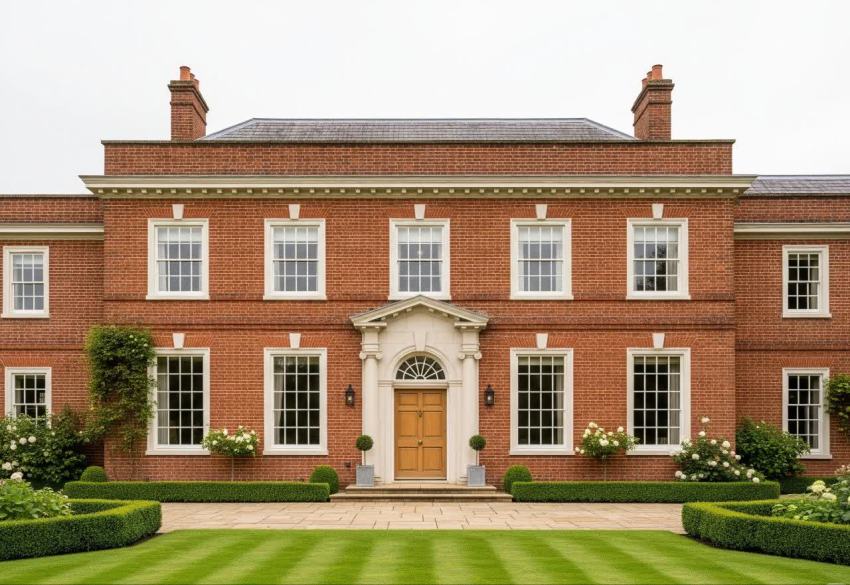
Key Features of a Georgian Home Style Interior
Upon entering a Georgian home style house, you are immediately surrounded by a world of refined elegance. Both the color scheme, as well as the furniture, all speak of restrained luxury and careful choice.
Color Palette: Sophisticated and Subdued Shades
Contrary to the less sharp, often darker tone of later Victorian home building design (for an interesting compare-and-contrast, read our Victorian style home guide article), interior Georgian home design favored lighter, more delicate colors.
- Soft, Blunted Colors: Think of dusty rose, pale yellow, sky blue, sage green, and various creams, greys, and off-whites. These colors offered a restful background that allowed architectural finishes and furniture to be the focus.
- Natural Pigment: Pigments were drawn directly from natural pigments of the time, leaving a smooth, almost powdery finish that appears timeless and sophisticated.
- Trim: Walls inside the house were often painted a mellow color, with intricate plasterwork, cornices, and window surrounds picked out in strong white or off-white to highlight their dainty details.
Furniture and Layout: Elegant and Functional
Georgian furniture in the home reflected the era’s growing affluence and refinement. Refinement and comfort took top priority.
- Walnut and Mahogany: Rich, sumptuous woods, these were popular for use in furniture, often polished to high brightness to bring out their beautiful grain.
- Elegant Silhouettes: Although massive, pieces of furniture possessed elegant proportions and often features gracious curves, cabriole legs, and delicate carving. Thomas Chippendale, George Hepplewhite, and Thomas Sheraton were especially powerful designers.
- Functional Organization: Spaces were designed for specific purposes (drawing rooms, dining rooms, libraries), and furniture was arranged to facilitate conversation and freedom of movement and was sometimes arranged symmetrically to serve as an embellishment of the room’s aesthetic.
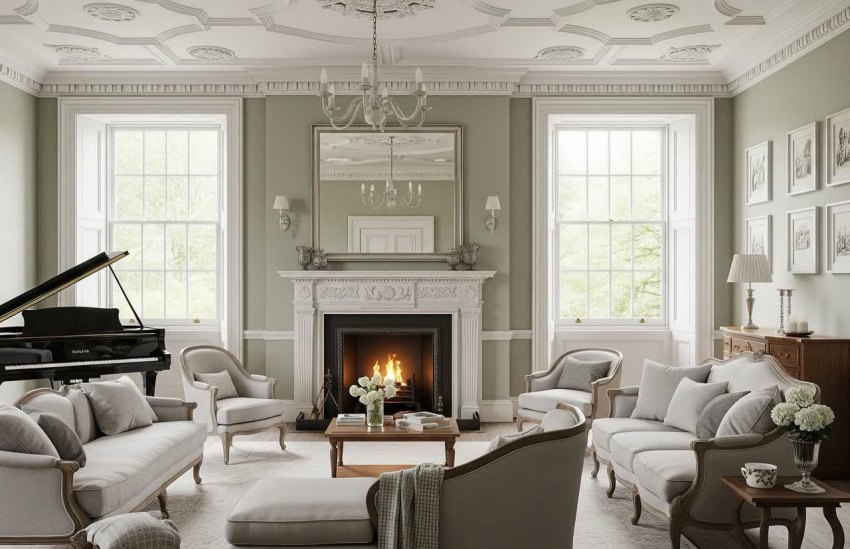
Lighting: Grand Yet Gentle
Georgian home style lighting was all about creating a warm, inviting ambiance, typically using natural light supplemented by candlelight.
- Tall Sash Windows: A defining feature, these multi-paned windows allow ample natural light to flood the interiors, imparting a feeling of lightness and airiness to the rooms.
- Chandeliers and Wall Sconces: Typically made of brass, silver, or crystal, these were the primary source of artificial light, their reflective surfaces amplifying the light from candles.
- Mirrors: Large, decorative mirrors were frequently used to reflect light and give the impression of more space, strategically placed to maximize lighting.
Modern Georgian Home Style: A Contemporary Renaissance
Strongly grounded in the past, Modern Georgian home style is surprisingly adaptable when it comes to adapting to contemporary living. It’s a question of redefining the timeless principles of proportion, symmetry, and classical beauty in terms of a modern perspective.
Simplified Symmetry: Less is More (But Still Grand)
Contemporary Georgian home design assumes the essential precepts of its ancestor but with a lighter, more restrained hand. It’s a confirmation of the fact that timeless beauty never truly falls out of fashion.
- Simplified Details: Though still appreciating classical motifs, contemporary interpretations might feature less complicated plasterwork or plainer cornices, allowing the architectural form itself to be the focal point.
- Crisper Palettes: Whites, greys, and clean neutrals form the predominant background, offering a lighter and more contemporary look, but still with the possibility of bursts of strong color in textiles or artwork. (Compare, for example, our feature on minimalist interior design ideas and inspiration).
- Contemporary Furnishings: While traditional forms can be referenced, furniture can also be contemporary and sleek, creating a bold contrast with the traditional architectural envelope. This creates a fascinating tension between new and old.
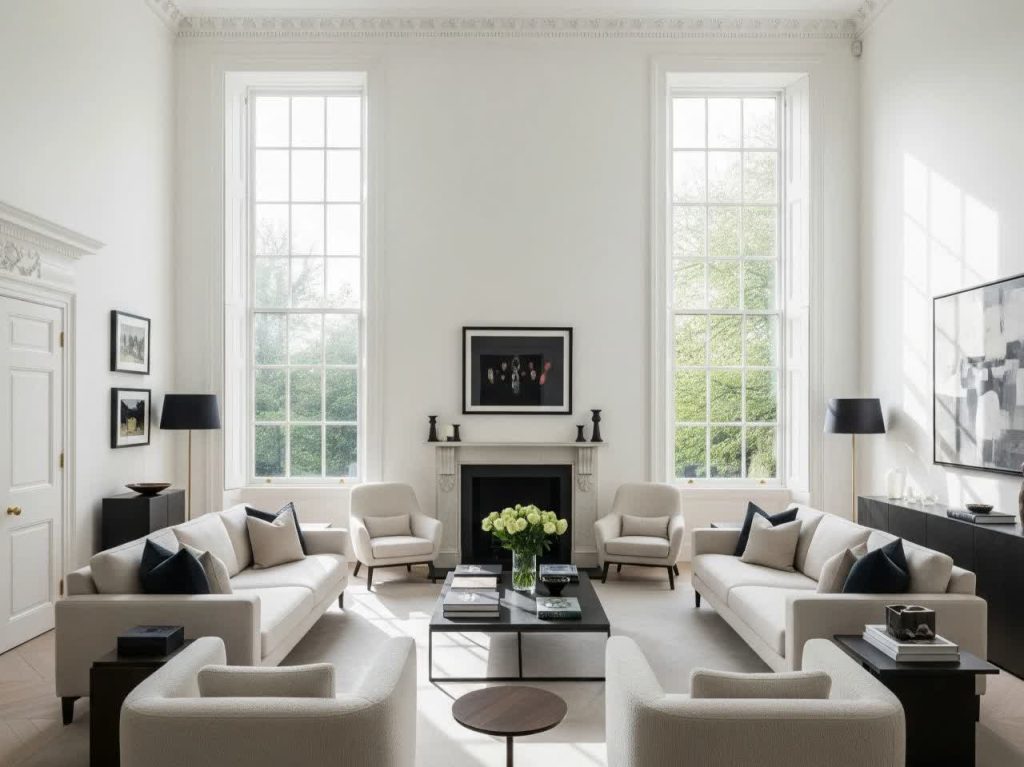
Bringing Georgian Elegance into Your Home: Practical Tips
You don’t need a grand country estate to introduce the classic sophistication of Georgian home style into your house. Some practical tips are:
- Embrace Symmetry: In furniture arrangement, art hanging, and even in window treatments. Think in pairs – two lamps on a console, two armchairs flanking a fireplace.
- Accentuate Proportion: When choosing furniture, choose pieces that are proportional to the room. The high ceilings in Georgian homes welcome taller pieces, but balance is key.
- Opt for a Muted Color Scheme: Start with pale grey, cream, or pale blues for walls. Crisp white is reserved for trim and ceiling decoration.
- Invest in Timeless Pieces of Furniture: Look for well-made pieces in dark wood (mahogany, walnut) with traditional lines. You can mix new pieces with antiques or vintage pieces.
- Architectural Accents: If you are renovating, incorporate crown molding, dado rails, or fireplace surrounds that echo Georgian sensibilities. If not, then even well-chosen picture frames or mirrors can mimic the formality.
- Intentional Lighting: Use chandeliers or sleek pendants as a statement piece, paired with classic table and floor lamps for general illumination.
- Elegant Textiles: Use natural fabrics like silk, velvet, or linen in solid colors or subtle patterns. Avoid busy prints.
- Art and Decor: Opt for classical portraits, landscapes, or botanical prints. Display collections neatly in display cabinets or on shelves. Balance heavily decorated pieces with plainer, more sophisticated objects.
The Function of Art and Decor in Georgian Home Style
Art and decor in Georgian home style were particularly selected to contribute to the sense of intellectualism and sophistication.
- Portraiture: Often featuring family members or famous persons, portraits were a matter of course, offering a personal and historical interest.
- Landscape Paintings: Depicting idyllic scenery or classical ruins, these appealed to the era’s appreciation of nature and antiquity.
- Ceramics and Porcelain: Fine china, Wedgwood pottery, or Delftware displayed were not unheard of, and the pieces were usually symmetrically arranged in built-in niches or on console tables.
- Clocks and Mirrors: Elaborate grandfather clocks and oversized, gilded mirrors were not just functional but were also key decorative elements, reflecting light and adding grandeur.
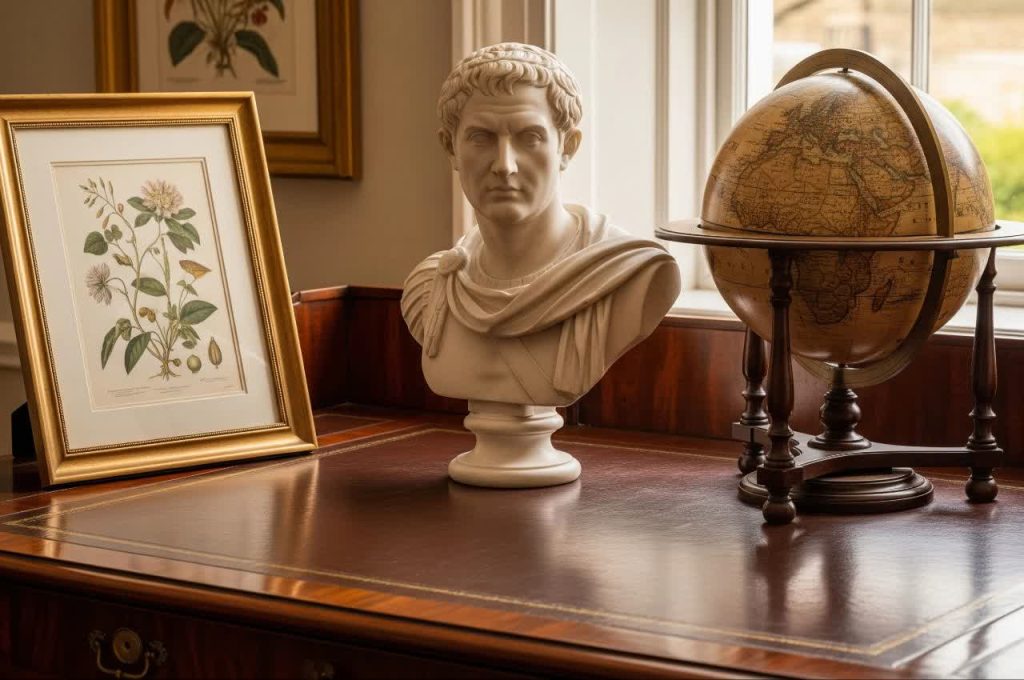
Georgian Home Style in Context: More Than the Facade
To best appreciate Georgian home style, it’s helpful to understand its position in history and how it stands apart from other popular architectural periods.
Georgian Home Style vs. Colonial and Victorian: A Comparison Look
While each period has its own special charm, a comparison will help to highlight what distinguishes Georgian home style.
- Colonial House vs. Georgian Home: Often confused, American Colonial architecture (and especially early examples) comes before the full development of Georgian and is apt to be plainer and less formal. While having some symmetry, Colonial homes were less formal and constructed with less decorated classical detail, which reflected the early stage of development in America. Georgian homes, both American and British, reflect a more developed, larger, and strictly classical approach.
- Georgian Home vs. Victorian Home: The ultimate contrast. Georgian is marked by symmetry, restraint, and classical balance. Victorian (which followed Georgian) embraced asymmetry, ornamentation, and eclecticism. Victorian homes have irregular rooflines, turrets, and assorted materials, with interiors that are darker, more congested, and more filled with a vast array of patterns and textures. Where Georgian whispers elegance, Victorian is inclined to trumpet profusion.
The Enduring Allure of Georgian House Design
Why is Georgian house design so long-standingly in vogue? I believe it’s because it offers a sense of timelessness and durability in a fast-changing world. Its roots in classical ideals provide a foundation of loveliness that doesn’t change, not ruled by the vagaries of momentary fashion. It’s a measure of the power of thoughtfully designed decoration – where every element has its position and contributes to a balanced whole.
- Architectural Integrity: Georgian houses are famous for their solid construction and durability, often being considered sound investments.
- Sense of History: Living in or developing a Georgian-style neighborhood places you in the tradition of centuries-long history and richness of culture.
- Flexibility: As formal as it is, its uncluttered lines and solid shape readily conform to numerous interior design choices, from solidly traditional to boldly contemporary. Such flexibility is a major reason that it has survived in popularity over two centuries later.
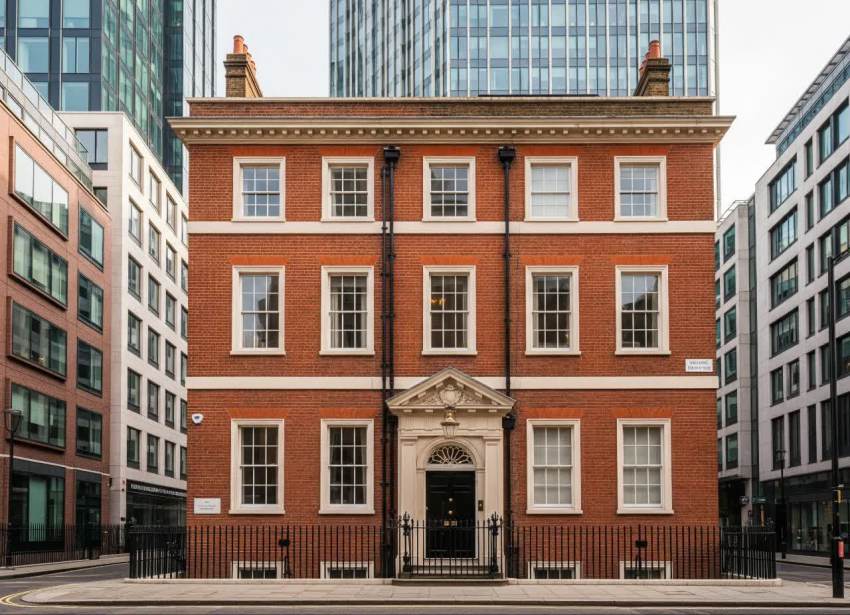
Summary: Embracing the Elegance of Georgian Home Style
Georgian house style is more than a bit of history; it’s a living design principle that embodies a love of balance, proportion, and understated detail. By learning from its classical heritage and taking on its key principles – from symmetrical planning and muted color schemes to robust, functional furniture – you can bring your own home to life with a sense of timelessness.
Whether you’re looking to recreate an historic building in earnest or simply introduce a touch of classic sophistication into a modern home, Georgian style is a cornucopia of ideas. It’s an invitation to appreciate ageless beauty and create a space that exudes quiet confidence and understated refinement.
What aspects of Georgian domestic style do you enjoy most or find the most challenging to integrate?
FAQ: Your Questions About Georgian Home Style Answered
What is a Georgian style house?
A Georgian-style house is chiefly identified by its strict symmetry and equal proportions. Features include a rectangular shape, a centrally placed front door, evenly spaced windows (often sash windows) arranged in grid fashion, and often a plain, plain brick or stone facade. Internally, the rooms are typically rectangular with central fireplaces and classical building details like cornices and moldings.
What period is the Georgian style house?
The Georgian style house era typically runs from 1714 to 1830, the reign of the first four King Georges of Great Britain (George I, George II, George III, and George IV). It was a period of widespread employment of classical building practices that had a great influence on construction design in all parts of Britain, its colonies (the future United States among them), and other parts of Europe.
How would a Georgian house differ from a Victorian house?
The strongest difference lies in their approach to symmetry and ornament. Georgian homes emanate strict symmetry, well-proportioned relation of parts, and a more conservative, classical appearance with cleaner lines. Victorian houses (1837-1901), on the other hand, often feature asymmetry, more elaborate and varied ornament (towers, turrets, complex rooflines), variety of materials, and generally a more eclectic, less formal appearance, reflective of the industrial age and moving away from classical restraint.
How is a colonial house different from a Georgian house?
Even though American Colonial architecture evolved into and was influenced by Georgian, there are distinctions. Early Colonial houses (around 17th to early 18th century) were less decoratively detailed, more functional, and plain, according to the practical needs of the settlers and local construction traditions. Georgian houses (mid-18th to early 19th century) are a more refined, academically classical interpretation of architectural form, with more adherence to symmetry, Palladian measurements, and more elaborate decorative ornamentation, modeled directly on European architectural forms of the time.
Did reading this article change your perception of Georgian home style? Share in the comments below!
Clevered by architecture history? See more interesting home styles on serenihouse.com!
